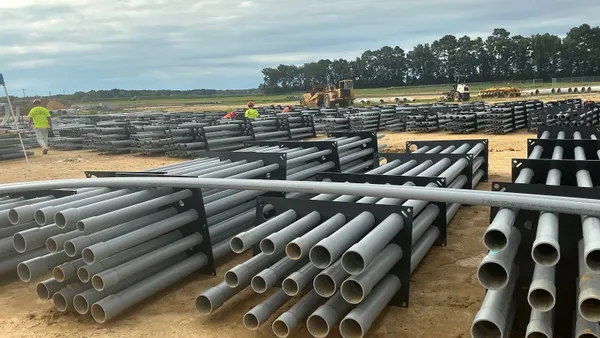Dive Brief:
- Construction will likely see "a substantial lift in coming months" with the enactment of the $1.14 trillion fiscal year 2016 Omnibus Appropriations bill, which increases spending for many federal construction programs and gives extensions to renewable energy tax credits for wind, solar and geothermal projects and other business tax incentives, the Engineering News-Record reported.
- The General Services Administration’s construction and acquisition account scored $1.6 billion — triple its past funding — which includes $948 million for new courthouses. In addition, the Department of Veterans Affairs, which has faced a barrage of criticism from Washington and elsewhere for its construction budget and management debacles, saw its construction account more than double to $1.2 billion, although $649 million of that amount is contingent on the VA entering into an agreement with another federal entity to manage construction projects of $100 million or more.
- Infrastructure also got a boost from the bill, the ENR reported, with an increase of 5% in the federal-aid highway obligation ceiling to $42.4 billion and an 8% increase in the Federal Transit Administration budget to $11.8 billion. Funding for military construction increased 16% to $7.2 billion, and the Army Corps of Engineers civil works program received a 10% increase, to $6 billion.
Dive Insight:
The bill also included some general business incentives affecting the construction industry. The measure extends the tax deduction for energy-efficient commercial buildings, gives a permanent extension to the Section 179 provision allowing small businesses to expense large capital equipment purchases, and grants a two-year delay of a tax on "Cadillac" health care plans.
Jimmy Christianson, director of government affairs for the Associated General Contractors of America's federal and heavy construction division, said that, because of the bill's construction spending provisions, "it will be a much better fiscal year in 2016 for construction than it was in 2015, and even compared to some years prior."
Christianson told ENR the GSA funding was particularly unexpected, as House and Senate appropriators recommended anywhere from zero to $181.5 million. He added that the extra money for the VA was most likely an effort to get other delayed VA construction projects off the ground.
However, not all areas of the industry saw a bump in cash. The Federal Aviation Administration’s Airport Improvement program remained at $3.35 billion, and the Dept. Of Transportation’s TIGER grant program, which funds a wider group of transportation projects like bridges and pathways, also remained frozen at $500 million.
Programs that saw construction budgets slightly reduced included the Environmental Protection Agency’s state and tribal water grants and funding for the State Department embassy security upgrades and construction.
Marco Giamberardino, National Electrical Contractors Association executive director for government affairs, told the ENR that having the full bill in place will give contractors "a predictable funding stream during the busy construction season."
Between this bill and the five-year highway bill passed by Congress earlier this month, the construction industry should be busier than ever next year, which begs a familiar question: Where is the industry going to go for a reliable stream of skilled workers?
Experts have widely agreed that the increased employment numbers from the last few months, while impressive, are mostly due to softening in the energy and manufacturing sectors and higher pay. However, most have said these numbers are not sustainable unless the government and private sectors get serious about training a new crop of workers to come into the industry.
The AGC reported this month that employment was up in November with year-to-date growth in all but six states. Chief Economist Ken Simonson said that improvement could have been even stronger if the industry had enough workers to fill available positions. In fact, the Associated Builders and Contractors said that the lack of skilled workers has constrained backlog growth in recent quarters to the point where firms are turning down work.












